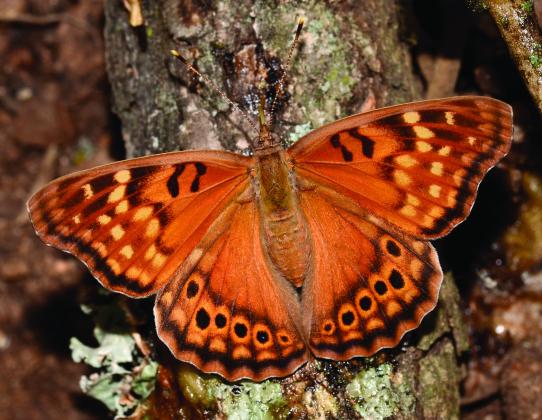The tawny emperor
With its wings closed, the tawny emperor is a rather inconspicuous butterfly.
It resembles a dead leaf, in my opinion, but that is almost certainly a survival mechanism.
However, when the tawny emperor opens its wings, it sports an array of bold orange coloring combined with numerous spots and stripes.
It is very similar to the creature I featured two columns back, the hackberry emperor, which is understandable, as the two are closely related.
The hackberry emperor is more common, and its post-median eyespots with powdery blue-green centers gives it perhaps a flashier look with its wings closed.
But with wings open, the tawny is more striking, in my opinion.
Duller, medium-sized butterflies like these often aren't in the limelight as much as brighter, flashier species, such as swallowtails and monarchs, but I enjoy encountering them just as much, and sometimes even more, than the bigger ones.
These butterflies seem to have kooky personalities, whereas the others often don't seem to have them at all.
Emperors are pretty quick to fly away when you approach, but they won't go far and will allow you to get close, provided you take your time.
They aren't easy to photograph and seem quite curious as to what I'm doing when I attempt to get close.
Emperors are quite affable and will land on people who are willing to allow it. They most likely do that to gather the salt from human perspiration.
Appearance
The tawny emperor has a wingspan up to 2 ¾ inches, and it is a little larger than the hackberry emperor.
As mentioned before, its wings have the appearance of a dead leaf underneath (photo).
Above, it has various shades of orange and two bold black bars near the "shoulders," which stand out on its forewings (photo).
Unlike the hackberry emperor, the tawny’s forewing tips are not dark with white spots, and there is no distinct black spot on each forewing.
Females are larger than males, and, even though quite striking in appearance, are slightly duller than males.
The caterpillar of the tawny emperor is pale green with a dark blue-green line on the back. Its head has two horns that have branch-like extensions.
Food
These are not typical butterflies that go from flower to flower for nectar. Emperor butterflies feed on tree sap and sometimes nectar, rotting fruit, dung and even carrion.
Like the hackberry emperor caterpillar, this species' caterpillar also feeds on the leaves of hackberry trees.
Range
These butterflies are found anywhere in Oklahoma where hackberry trees are located and over most of the eastern United States.
Habitat
Open woodlands and forest edges, wherever hackberry trees are found.
Odds and ends
Please don't forget to check out my Randy's Natural World YouTube channel -- www.youtube.com/user/randyadventure.
(Editor's Note: Randy Mitchell is a freelance writer and photographer. He has been an avid birdwatcher, nature enthusiast and photographer for more than 40 years. Reach him at rnw@usa.com.)


